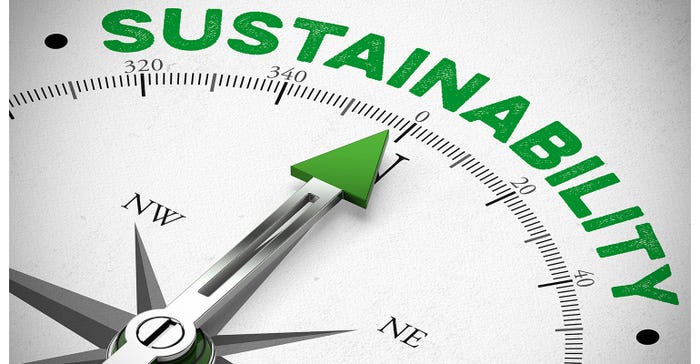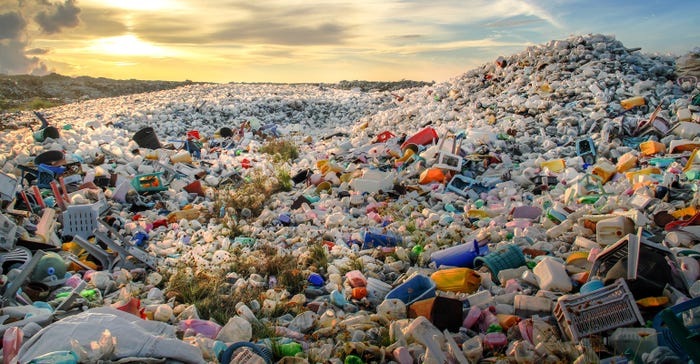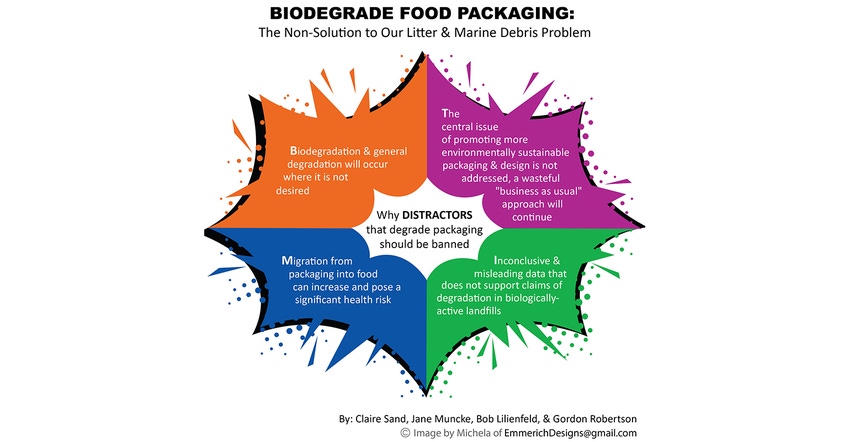Are Biodegradable Additives for Food Packaging a Solution? No, They Make It Worse
We know that biodegradable additives in packaging are the wrong solution to the plastics problem, so why are they still on the table?
"...there is always a well-known solution to every human problem — neat, plausible, and wrong."
— Henry L. Mencken
As we all know, packaging plays a major role in achieving a more sustainable food system. However, consumers hear of and sometimes encounter rivers clogged with packaging, islands in oceans made of garbage, and discarded packaging littering the roadside.
We all would like this ill-disposed packaging to "just go away!" And, we do have the technology to make it disappear. Yes, this packaging in the oceans, rivers, lakes, and streets can easily be degraded, and we can have more space in our landfills if we add degradable technology to packaging. Right?
Wrong!
Degrading packaging waste is a neat, plausible, and wrong answer because:
Compounds that remain will be released that are not intended to enter oceans and land.
Cleaning up these remaining compounds is much more complicated than retrieving a plastic bottle from the water or roadside.
We need to adopt more environmentally sustainable sourcing of packaging materials and design, and properly collect and sort packaging for proper disposal.
If we know that degrading packaging is the wrong answer, why is it still on the table, so to speak?
There is an issue because degrading packaging waste is once again being promoted as a solution. Besides the old OXO additives currently in disfavor, there are apparently a host of new ones available. We have named them distractors, as they distract our attention from the real goal: reduce the negative environmental impact of food packaging both by itself and, in its more important role, to protect the food it contains.
Distractors include technology for use on and in packaging materials to promote their biodegradation and degradation.
Some background: A few years ago, the OXOs, which promote degradation of packaging in water, on land, and in landfills, were adopted and then "unadopted", once more rational minds prevailed. OXOs are an array of additives that are added to packaging to facilitate degradation. OXOs were banned because they break down packaging into macro-, micro-, and nano- sized pollution. As packaging professionals know, proper disposal of the packaging is essential. Much packaging can be minimized, reused, and recycled to limit the impact on the environment of getting food to people. Other packaging can be used to recover energy in waste-to-energy incineration or biologically active and inactive landfills. Some can be degraded in controlled facilities. When research showed that uncontrolled degradation of packaging (primarily paperboard and plastic) would result in the release of compounds that would cause macro-, micro-, and nano- sized environmental disasters, these so-called OXOs have been banned in some countries and regions, including the EU. Organizations such as the Sustainable Packaging Coalition and businesses (e.g., Walmart) also frown upon or ban them, as well.
However, the distractors are on the rise — we have OXOs, as well as non-OXO technology, promoted again to degrade packaging.

Four reasons why distractors should be banned.
1. Using distractors, biodegradation and general degradation occur where it is not desired.
The main issue is that distractors also promote degradation in all environments. This biodegradation releases (from the coated package) potentially toxic entities on the rest of the earth that is not occupied by landfills. This covers a large space. Moreover, this space includes where crops are grown.
This is especially relevant to distractors because they claim to induce biodegradation in many types of packaging – paper, plastic, multilayer. However, when distractors induce degradation, any chemicals present in the degrading packaging will get released into the environment. This is problematic since packaging materials can contain hazardous or unknown/untested chemicals that subsequently diffuse in the environment.
The environment is not controlled (sealed as in landfills); bio or other marine or land degradation (excluding controlled environments and landfills) is not advisable and irresponsible.
ATSM 5511, 5526, and other relevant ASTM chemical testing standards for bio and other degradation products are limited to heavy metals and known organic pollutants. Notably, PFAS was not measured until 2 years ago. Ideally, these standards would address impacts of degrading packaging on soil fertility as such, but further developments are required.
The claim that distractors promote degradation from A to B in oceans by merely going faster is not valid. Biodegradation of packaging should not occur in the marine environment or on land, fast or slow. When it does, it releases Greenhouse Gases (GHGs), potential toxins, and unknown micro-substances. Promoting degradation of materials in an uncontrolled environment is not environmentally friendly but instead contributes to accelerating entropy and chemical pollution.
Data showing that plants can grow in soil that includes packaging biodegraded with distractors is very package specific. In an industry with multiple converters, it is unlikely that all packaging that can be coated with distractors would degrade (based on the definition) into non-toxic entities. Research has shown that known hazardous chemicals are legally used in food packaging.
Distractors cause the same uncontrolled biodegradation that led OXO-degradable to be banned after much fanfare and research.

2. Overall, distractors promote "business as usual" by not addressing the central issue of promoting more environmentally sustainable packaging and design.
Converting to more environmentally sustainable packaging materials and design is what we must achieve to reach Net Zero's goal quickly. This likely means moving away from single-use, short-term use food packaging as much as possible to adopting new business models that use reusable, refillable containers. It means redesigning not only packaging but how foods are produced, processed, and consumed.
The converging crises that challenge society right now should be an excellent reminder that "business as usual" solutions such as distractors and their related substances are not a wise or a viable option.
The complexity of "food packaging" must be fully understood to find adequate responses to the challenges. Quick-fix solutions are tempting because they do not require reinventing the wheel, but such "low hanging fruit" create solutions that become tomorrow's problems.
3. Distractors could pose a significant health risk when used in food packaging.
Degradation, while the food (produce, for example) is in the package, has major ramifications that include:
Food safety issues;
Migration of additives that have been released from the degrading package into food
Human exposure of additives in packaging that degrades while in food contact;
Health impacts on the gut microbiota of additives in packaging that degrade while in food contact;
Food waste increases;
Degradation of the package containing food may increase food waste.

4. Distractors’ use in a biologically active landfill has a strong value proposition because it is a controlled environment. However, there are major concerns with the claims.
Testing is commonly done using ASTM D5511, which applies to anaerobic digesters, not biologically active landfills. In this standard, materials are exposed to a methanogenic inoculum commonly associated with anaerobic digesters operating on pretreated household waste.
Obviously, the ASTM D5526 (Standard Test Method for Determining Anaerobic Biodegradation of Plastic Materials Under Accelerated Landfill Conditions), while more costly, should be used instead. The multiplier may be the same, but the total amount of degradation is not.
Lastly, landfill volume is currently being reduced using other solutions.
About the authors
Combined, the authors have 150+ years of experience in food packaging. Their expertise areas include more sustainable packaging, migration of packaging components into food, food packaging science, and engineering, and strategies and techniques toward building a more sustainable food system.
Claire Sand, PhD, has 30+ years of experience in industry and academia. She's owner of Packaging Technology and Research and Gazelle Mobile Packaging and is an Adjunct Professor, CalPoly, Michigan State University, and the University of Minnesota.
Jane Muncke is an environmental toxicologist, focusing on chemicals and their impacts on health — primarily in food packaging and other types of food contact materials. For nearly 9 years she has been managing director of the Food Packaging Forum in Zurich, Switzerland, which serves to “unwrap the facts about chemicals in all food packaging materials and related health impacts on humans and the environment.��”
Robert (Bob) Lilienfeld has been involved in sustainable packaging for 25 years, working as a marketing executive, consultant, strategic planner, editor, writer, and communications expert. He’s President of Robert Lilienfeld Consulting, working with materials suppliers, converters, trade associations, retailers, and brand owners.
Gordon Robertson has for 17 years been a principal consultant, expert witness, author and trainer for Food+Packaging+Environment. Prior to that he was for 11 years Vice President for Environmental & External Affairs for Tetra Pak in their Asia Regional Headquarters. Before that he was Foundation Professor of Packaging Technology at Massey University, New Zealand where he taught courses in food packaging for 21 years.
About the Author(s)
You May Also Like








